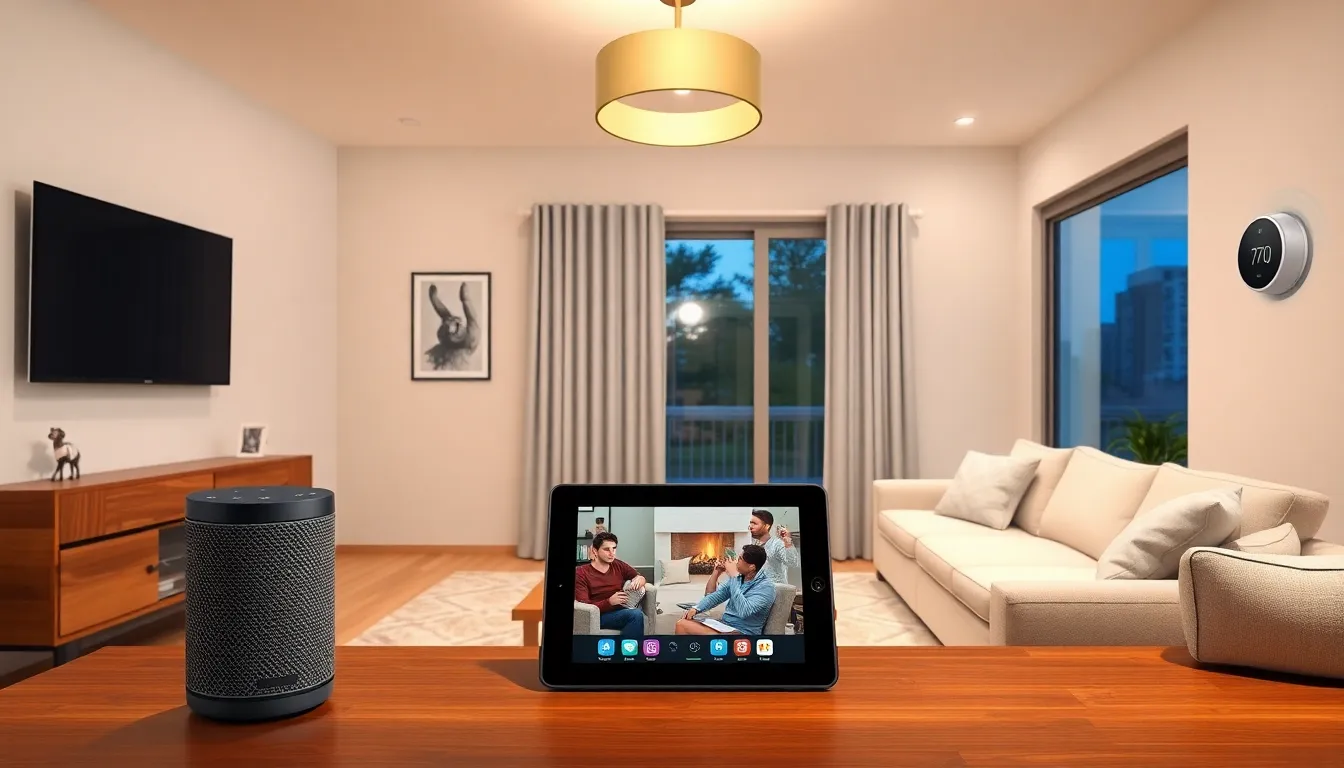Table of Contents
ToggleImagine a world where your coffee brews itself, your thermostat knows when you’re cold, and your front door unlocks at your command. Welcome to the realm of IoT home solutions, where everyday living gets a tech-savvy upgrade. These smart devices don’t just make life easier; they turn your home into a futuristic haven that even your sci-fi-loving friends will envy.
Overview of IoT Home Solutions
IoT home solutions utilize a network of interconnected devices, enhancing daily living by promoting automation and connectivity. These technologies allow users to control various aspects of their homes remotely, making life more convenient.
Definition and Concept
IoT home solutions refer to a system of smart devices connected to the internet that communicate with each other. This connection enables remote management and monitoring, improving overall efficiency and security. For example, smart thermostats learn users’ preferences, optimizing energy usage. Homeowners benefit from increased comfort and ease of use, transforming traditional living into a high-tech experience.
Key Components
Key components of IoT home solutions include smart speakers, cameras, sensors, and appliances. Smart speakers act as a hub, enabling voice control and interaction with other devices. Security cameras provide real-time surveillance, enhancing home safety. Sensors monitor conditions such as temperature and motion, alerting homeowners to potential issues. Smart appliances, like refrigerators and ovens, offer convenience through remote access and automation. Combining these elements creates a seamless, interconnected home environment.
Benefits of IoT Home Solutions

IoT home solutions provide substantial advantages for users. These benefits range from increased convenience to enhanced security.
Increased Convenience
Smart home devices simplify daily tasks. Programmable smart speakers can play music or control lighting with a simple voice command. Automating routines, such as brewing coffee at dawn or adjusting thermostats while away, saves time and increases comfort. Remote access allows users to manage appliances or check security cameras from anywhere. Smart locks enable easy home entry, eliminating the need for traditional keys. Each device communicates seamlessly, ensuring a fluid home environment that caters to individual preferences. Time and effort are significantly reduced, leading to a more efficient lifestyle.
Enhanced Security
IoT home solutions heighten safety and security. Smart cameras monitor the property, providing alerts for unusual activity in real time. Sensor-equipped devices detect motion and notify homeowners instantly, offering peace of mind. Integration with smartphones allows for remote monitoring, enabling users to check their homes while away. Home automation expands security features, such as simulating occupancy with timed lighting. Additionally, smart locks enhance access control, granting entry to trusted individuals while deterring potential intruders. These advanced solutions foster a safer living environment, making homes more secure for families.
Popular IoT Home Solutions
Smart home solutions encompass a variety of devices designed to improve convenience and security. The most notable systems include smart lighting and smart thermostats.
Smart Lighting Systems
Smart lighting systems enhance home ambiance through automation. These systems allow users to control lights remotely via smartphone apps or voice commands. They offer customizable settings, including brightness and color, adapting to personal preferences effortlessly. Many smart lighting solutions integrate with existing home networks, enabling scheduling and automation based on daily routines. These features not only save energy but also improve safety by illuminating paths when motion is detected. Popular brands like Philips Hue and LIFX provide a range of products that cater to diverse lighting needs.
Smart Thermostats
Smart thermostats optimize home heating and cooling for maximum efficiency. Users can program these devices to adjust temperatures according to their schedules, significantly reducing energy consumption. Smart models, like Nest and Ecobee, learn user habits, adapting settings to improve comfort over time. These devices often connect to other smart home systems, providing integration with voice assistants and other IoT solutions. By monitoring energy usage and offering insights, smart thermostats empower homeowners to make informed decisions about energy management and savings.
Challenges and Considerations
IoT home solutions offer numerous benefits, yet they come with several challenges and considerations that users need to address.
Privacy and Security Risks
Privacy and security risks pose significant challenges for IoT home solutions. Devices often collect sensitive data, creating vulnerabilities that malicious actors can exploit. Cybersecurity threats such as hacking can target connected devices and compromise personal information. Recent reports indicate that over 25% of smart home devices face potential attacks. Consequently, users must ensure their networks are secure and prioritize strong passwords. Regularly updating device firmware also strengthens security measures against emerging threats. Homeowners may want to employ robust encryption protocols to further safeguard data transmissions. Ensuring privacy settings are correctly configured becomes crucial for maintaining control over personal information.
Interoperability Issues
Interoperability issues arise from the diverse range of devices and platforms in the IoT space. Different manufacturers often utilize varying communication standards, making it difficult for devices to seamlessly integrate. This lack of compatibility limits the overall functionality of smart home ecosystems. For instance, a user may find that a smart thermostat does not work with their existing security system, restricting automation potential. Such challenges necessitate careful selection of devices that support common standards like Zigbee or Z-Wave. Using platforms that promote interoperability can ease the integration process. Additionally, relying on hubs can simplify management of multiple devices by creating a unified control interface.
Future Trends in IoT Home Solutions
Future trends in IoT home solutions reflect rapid advancements in technology, reshaping the way users interact with their living spaces. Analysts predict significant developments in the coming years.
Emerging Technologies
Artificial intelligence (AI) plays a crucial role in shaping IoT home solutions. Companies are integrating AI into devices, enabling smarter decision-making and enhanced automation. Voice recognition technology continues to evolve, allowing devices to understand and execute complex commands. Device interoperability emerges as a key focus, promoting seamless communication between different brands and ecosystems. Additionally, blockchain technology enhances security, enabling decentralized data management and protecting user information. Adoption of 5G networks provides faster connections, allowing for real-time data transmission and improving responsiveness of smart devices.
Market Growth Predictions
Market growth for IoT home solutions shows impressive forecasts. Experts anticipate the market will reach $158 billion by 2024, with a compound annual growth rate of 25.5%. Rising consumer demand drives this expansion, as homeowners seek smarter living environments. Smart lighting, security systems, and appliances represent some of the most popular categories among users. Increased adoption of smart home technologies enhances energy efficiency, making them attractive to environmentally conscious consumers. Retailers report growing interest in comprehensive home automation packages that bundle various devices, offering convenience and cost savings. Major tech companies, including Amazon and Google, are investing heavily in IoT solutions, supporting robust market growth.
Embracing IoT home solutions transforms everyday living into a seamless experience filled with convenience and security. As technology continues to advance, the integration of smart devices enhances home automation and connectivity, making life easier for homeowners.
The benefits of improved energy efficiency and heightened safety are compelling reasons to consider these innovations. With the market poised for significant growth and major companies investing in this space, it’s clear that the future of home living is becoming increasingly intelligent.
For those looking to elevate their living environment, exploring IoT solutions presents an exciting opportunity to create a smarter and more efficient home.





